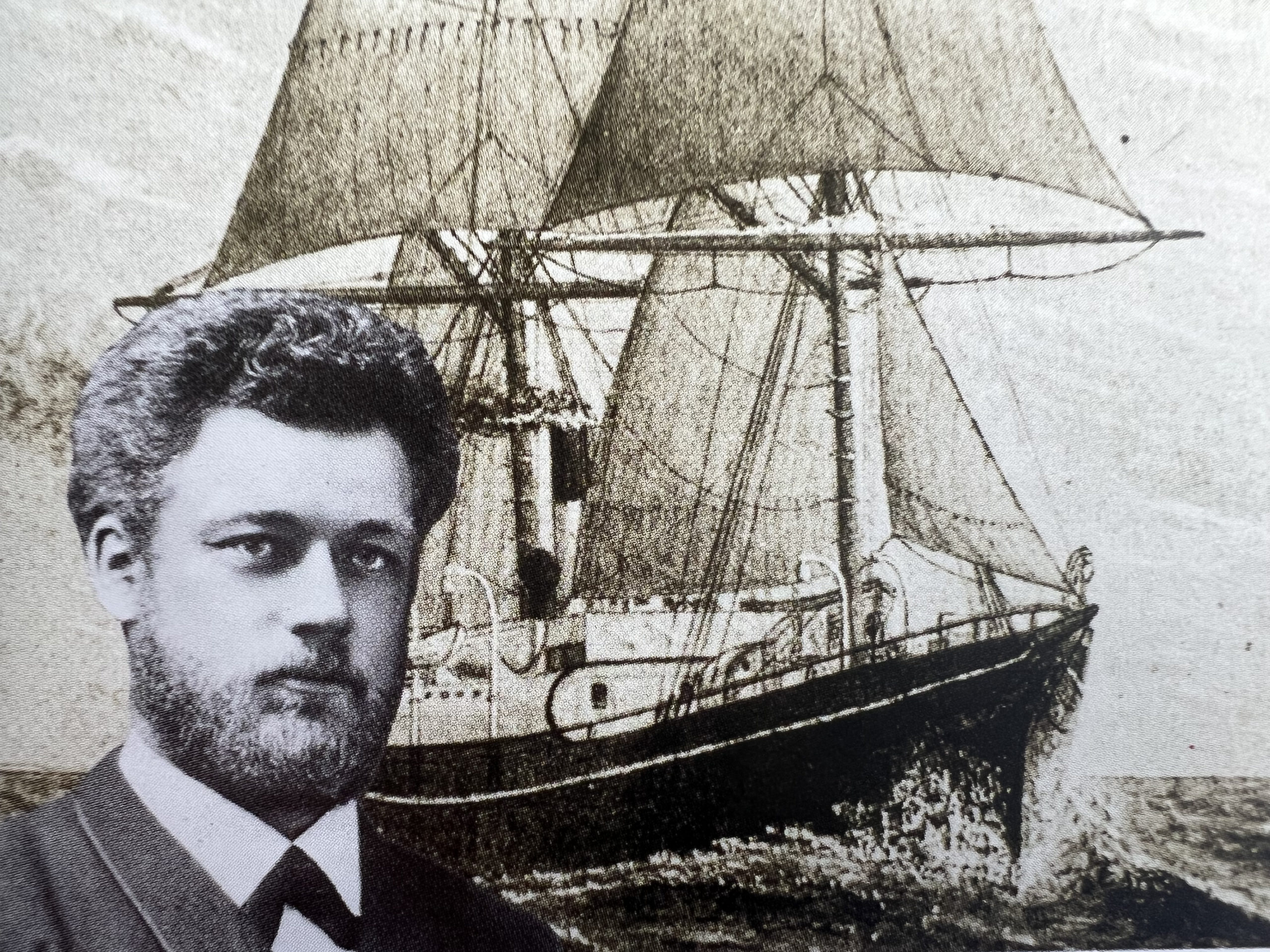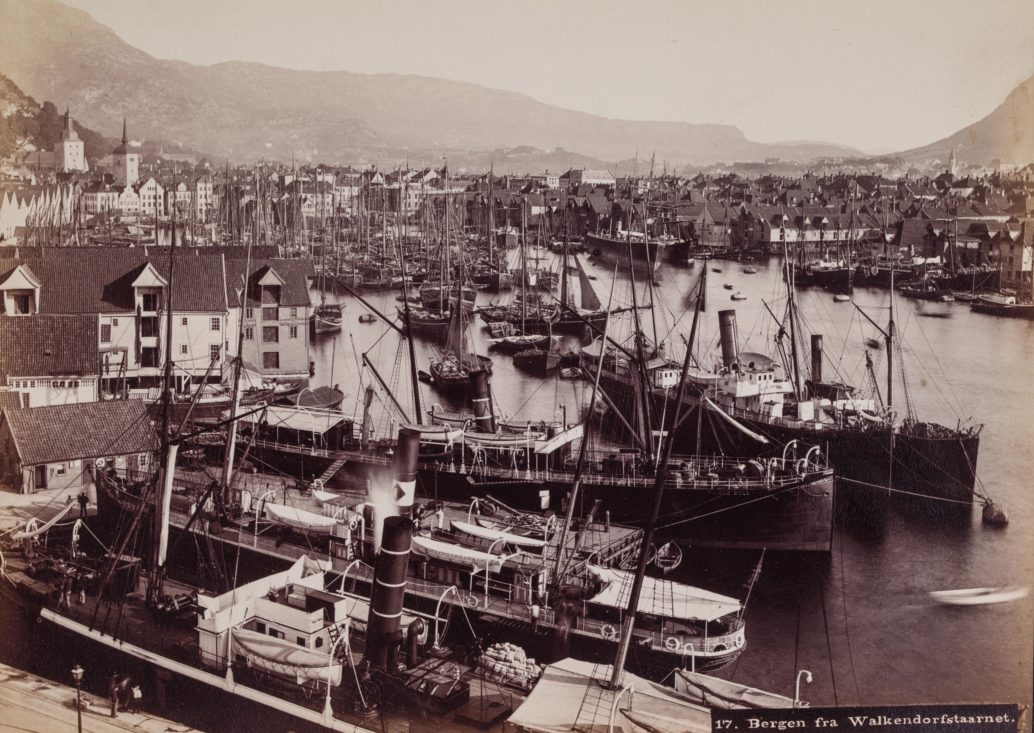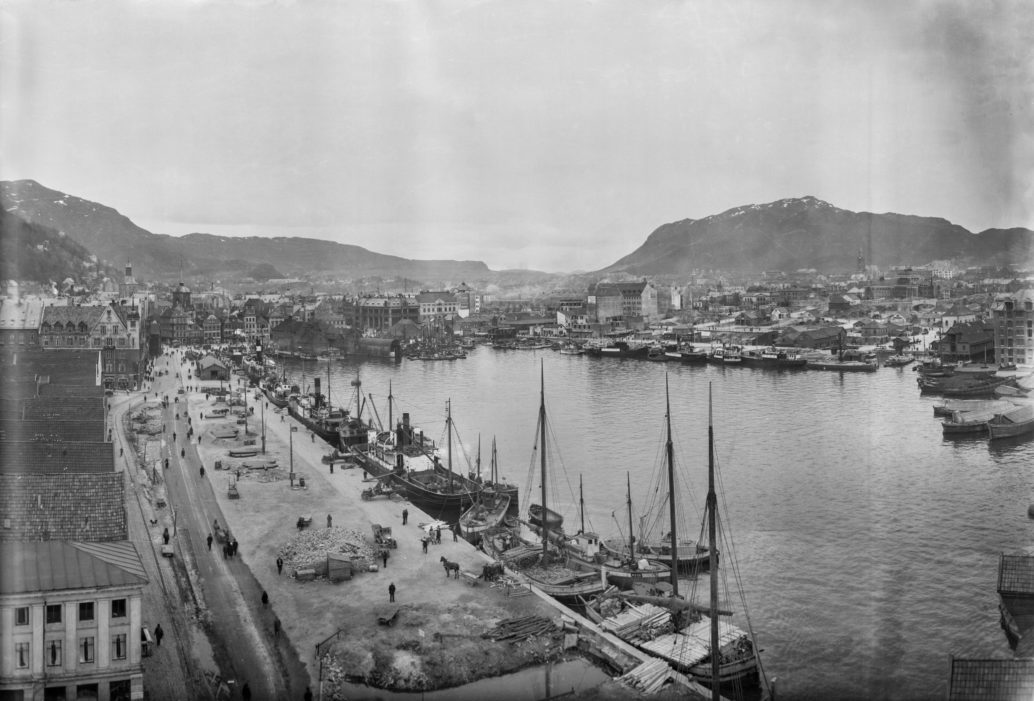

Steamships were replacing sailing ships, and the development of telegraphy opened up completely new ways of conducting trade and business. It was a time of upheaval, full of opportunities for those willing to take a chance.
Bergen 1878, Joachim Grieg takes a breath. His lungs fill with the cool, salty air. The city slowly but indeed becomes visible far ahead. Towers and spires protrude from a sea of roof tiles – a sight that had hardly changed since he left the city as a young sailor 13 years ago.
After rising through the ranks, he eventually became a captain. The last voyage was over. The summer voyages in the Norwegian Sea under the auspices of the North Sea Expedition had been a challenging but exciting time. Now, he was finally home.
Yet something was different—something that signaled that time did not stand still, even though Bergen had preserved much of its medieval character. The wooden houses that had previously dominated the cityscape began to give way to impressive commercial and office buildings in stone. New streets stretch through the old city structure, wide and straight, lined with magnificent buildings in various architectural styles.

New times, new opportunities
When he left Bergen, the city still had much of its medieval character—a dense, towering city of wooden houses clinging around the protective harbor. But just a decade later, things were changing at a breakneck pace.
Joachim felt both a certain excitement and anticipation for the new era. Bergen was moving forward as a city and as a center for the maritime industry to which he had ties. Steamships and telegraphy opened up entirely new ways of conducting trade and business. Joachim went ashore in Bergen during a transition time full of opportunities for those willing to take a chance.
And Joachim was precisely that – a man with drive and a commitment to shipping. He had the proper prerequisites to succeed in the new era. After years as a sailor, both on sailing ships and steamships, he knew the shipping industry from the inside. He had taken mate’s and machinist’s exams and gained valuable practical experience by working at Copenhagen’s Burmeister & Wain workshops.
The breakthrough of the fruit trade
In 1878, Joachim became a co-owner of Fredrik Johan Ellertsen’s ship brokerage firm in Bergen. Five years later, in 1883, he finally got his ship brokerage license and established Joachim Grieg & Co. in 1884. This would begin a maritime industrial adventure leading the family firm to the top of Norwegian and Nordic shipping.
Grieg started his business during major upheavals in the shipping industry. While most trade still took place with sailing ships, steamships were becoming increasingly prevalent. At the same time, telegraphy opened up completely new communication and coordination opportunities in the industry.
In 1885, Joachim received a very important assignment that would prove decisive for further growth. He was contacted by chartering agents from the New York firm Hurlbut & Co. They had discovered that the small, efficient Norwegian steamships were perfectly suited for the lucrative American fruit trade and asked Joachim for help in gaining control of this freight.
Joachim was well-suited to handle this business. He had experience as a ship captain from the West Indies and was well acquainted with time charter arrangements – a contract form that would become the dominant one for international freight. In addition, the Ellertsen firm, of which Joachim was previously a co-owner, had possibly already been involved in the fruit trade.
Scandinavia’s leading shipbroker
From 1886, Joachim Grieg & Co. entered into contracts for Norwegian ships in the American fruit trade and rapidly expanded its business. The success in this segment laid a solid foundation for the company’s growth and becoming Scandinavia’s leading ship broker.
The fruit trade was a breakthrough for the Grieg company. In 1890, Joachim’s younger brother, Halfdan Grieg Sr., was sent to New York to work at the office of Hurlbut & Co. before returning in 1892 and starting as a ship broker in the company.
In addition to the fruit trade, the company also engaged in insurance work and became an agent for the Spanke Line in 1894. Joachim opened his office in Kristiania (now Oslo) in 1899, led by Hans B. Blehr, to further exploit the opportunities. The Kristiania office quickly succeeded and began chartering ships for the fruit trade as early as 1900. The office had a significant competitive advantage, with a direct telegraph line to New York.
The Grieg company now operates in Bergen and Oslo and has set up ships on time charter for one to ten years. In addition to the fruit trade, they expanded their business to China and the fruit trade to Italy and South Asia.

Turbulent times
The success of the 1890s lasted a few decades. World War I would be very challenging for shipping companies like Grieg. The war brought unpredictable conditions, blocked trade routes, and reduced international cooperation, which limited the company’s opportunities.
However, the Grieg company also gained other experiences during the war years. As a neutral country, Norway greatly benefited from the historically high freight prices. This proved crucial for maintaining Bergen’s position as a hub between Europe and the USA during the war.
But after the end of the war, the situation became challenging. Reconstructing the Norwegian merchant fleet required significant investments from companies like Grieg. At the same time, the freight market collapsed when the temporary wartime demand for tonnage disappeared. It created economic difficulties for the Grieg company, which had long depended on the open international market.
The family business
In 1919, Joachim Grieg brought in his brother Halfdan Grieg Sr. and his son Einar L. Grieg as co-owners, and the company changed its name to Joachim Grieg & Co. In the following decades, the company was divided into two business areas: agency for marine insurance and liner shipping and ship brokerage that dealt with chartering, contracting, buying, and selling.
Throughout the interwar period, the same three brokers, Halfdan Grieg Sr., Sigurd Thorsnes, and Carl Pettersen, accounted for large parts of the ship brokerage business. Thorsnes was mainly responsible for chartering to the USA and tanker shipping, while Pettersen focused on buying, selling, and contracting ships.
Although Joachim Grieg himself gradually became more withdrawn from the company, he remained engaged and present throughout his lifetime. His far-reaching contacts and public offices were also important for the company’s development.
Joachim also played an active role in public life. In 1904, he sat on the consulate committee, and from 1906 to 1909, he was a parliamentary representative for the Free-minded Left in Bergen. In 1919, he bought Edvard Grieg’s home, Troldhaugen, and gave it to Fana municipality in 1923 to preserve it as a memory of Edvard and Nina Grieg. Joachim was awarded the Knight’s Cross of the 1st class of the Order of St. Olav in 1905.

A maritime group emerges
Although the Grieg company faced its challenges in the interwar period, Joachim laid a solid foundation that would bear fruit far into the future. The Grieg family’s maritime involvement would grow more significant and surpass the original ship brokerage firm.
In 1962, Star Shipping was established, and throughout the 20th century, the group grew ever larger through new acquisitions and establishments in shipping, logistics, seafood, and other maritime segments. Per Grieg Sr. (1932-2024) was the central driving force behind the Grieg Group’s development into an industrial giant. His ability to see new opportunities, just like Joachim’s, elevated the Grieg Group to become one of the country’s leading industrial conglomerates.
The Grieg Group was formally established in 1984 as a holding company for various business operations. In 1999, four siblings in the next generation, Per Grieg Jr., Elisabeth Grieg, Camilla Grieg, and Elna-Kathrine Grieg, took over the management of the group with equal ownership shares each. They continued to build on the foundation that Joachim Grieg had laid.

When Captain Joachim Grieg went ashore
One hundred forty years after Joachim Grieg established his ship brokerage firm in Bergen, the Grieg Group has grown into an international maritime group with over 1700 employees in eight countries. With over 11 billion kroner turnover in 2022, the Grieg Group is one of Norway’s leading maritime companies.
Joachim Grieg could hardly have imagined where his modest ship brokerage business in Bergen would end up. From a pioneer in the shipping industry’s transitional period in the 1880s, the company has evolved into a global group – proof of how much a person with a strong belief in the opportunities of the time and an indomitable faith in the future, drive, and business acumen can achieve.
Through generations, the Grieg family has shown an ability to adapt, expand, and think strategically, which has been crucial to the company’s success. From the fruit trade to the USA in Joachim’s time to today’s broad portfolio, the Grieg Group has constantly found new opportunities and adapted to changing markets. The foundation was laid when Captain Joachim Grieg went ashore in Bergen.